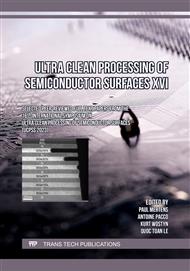[1]
T. Tanaka, Japanese journal of applied physics, 32(Part 1, N°12B), 6059-6064 (1993).
DOI: 10.1143/JJAP.32.6059
Google Scholar
[2]
I. Vos, ECS Trans., 41(5) 189-196 (2011).
DOI: 10.1149/1.3630843
Google Scholar
[3]
S.S. Iyer, IEDM Proceedings, p.33.1.1-33.1.4 (2012).
DOI: 10.1109/IEDM.2012.6479155
Google Scholar
[4]
A. Tournier, Pixel-to-Pixel isolation by Deep Trench technology: Application to CMOS Image Sensor, IISW (2011).
Google Scholar
[5]
B. Wu, J. Appl. Phys., 108, 051101 (2010).
DOI: 10.1063/1.3474652
Google Scholar
[6]
P. Garnier, Deep trenches cleanliness challenges for CMOS Image sensors, ECS Trans 80(2): 101-109 (2017).
DOI: 10.1149/08002.0101ecst
Google Scholar
[7]
Ansys® Mechanical APDL, Release 23.1, Theory Reference, ANSYS, Inc.
Google Scholar
[8]
B. Mielniczuk, Rupture of an evaporating liquid bridge between two grains, Acta Geophysica 62(5).
DOI: 10.2478/s11600-014-0225-6
Google Scholar
[9]
A. Pacco, Solid state phenomena, 145-146, pp.87-90 (2009).
DOI: 10.4028/www.scientific.net/SSP.145-146.87
Google Scholar
[10]
W. Merlijn van Spengen, J. Micromech. Microeng. 12 702 (2002).
DOI: 10.1088/0960-1317/12/5/329
Google Scholar
[11]
C. C. Yang, Solid State Phenomena, 187, pp.253-56, (2012).
Google Scholar


